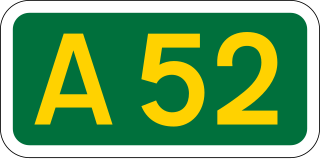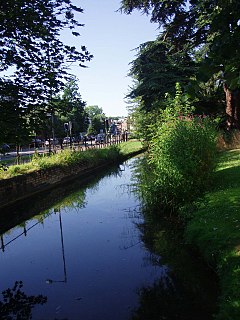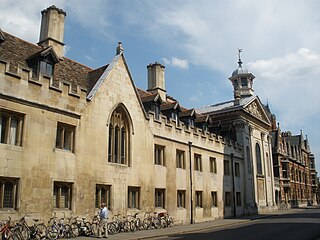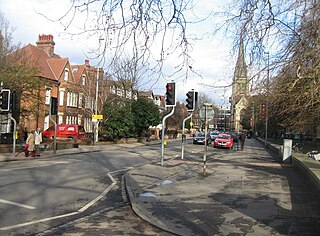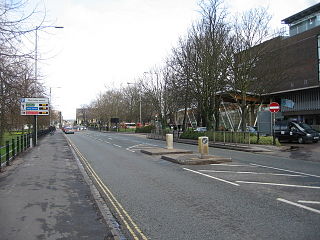


Hills Road is an arterial road (part of the A1307) in southeast Cambridge, England. [1] [2] It runs between Regent Street at the junction with Lensfield Road and Gonville Place (the A603) to the northwest and a roundabout by the Cambridge Biomedical Campus, continuing as Babraham Road (also part of the A1307) to the southeast.
The A1307 is a secondary class A road in Cambridgeshire and Suffolk between the A14 at junction 31 in Cambridge to Haverhill, Suffolk. From 2020 the former A14 between North of Cambridge and Huntingdon is reclassified as the A1307.

Cambridge is a university city and the county town of Cambridgeshire, England, on the River Cam approximately 50 miles (80 km) north of London. At the United Kingdom Census 2011, its population was 123,867 including 24,506 students. Cambridge became an important trading centre during the Roman and Viking ages, and there is archaeological evidence of settlement in the area as early as the Bronze Age. The first town charters were granted in the 12th century, although modern city status was not officially conferred until 1951.

England is a country that is part of the United Kingdom. It shares land borders with Wales to the west and Scotland to the north-northwest. The Irish Sea lies west of England and the Celtic Sea lies to the southwest. England is separated from continental Europe by the North Sea to the east and the English Channel to the south. The country covers five-eighths of the island of Great Britain, which lies in the North Atlantic, and includes over 100 smaller islands, such as the Isles of Scilly and the Isle of Wight.
On the corner with Lensfield Road is Our Lady and the English Martyrs Church. To the west of the road is the Cambridge University Botanic Garden. At this point, near the Cambridge War Memorial, Station Road leads to Cambridge railway station to the east. Near the southeast end to the west, just north of the junction with Long Road, is The Perse School, an independent school. The Cambridge Biomedical Campus is to the southwest of the roundabout at the southeastern end, at the edge of the city and houses Addenbrooke's Hospital. The original hospital was located on the Old Addenbrooke's Site on Trumpington Street in central Cambridge.
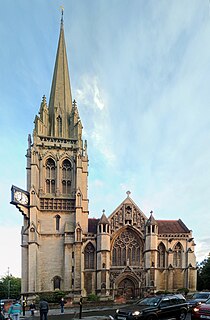
The Church of Our Lady and the English Martyrs (OLEM) is an English Roman Catholic parish church located at the junction of Hills Road and Lensfield Road in south east Cambridge. It is a large Gothic Revival church built between 1885 and 1890.

The Cambridge University Botanic Garden is a botanical garden located in Cambridge, England associated with the university Department of Plant Sciences. It lies between Trumpington Road to the west, Bateman Street to the north and Hills Road to the east.

Cambridge War Memorial is a war memorial on Hills Road, Cambridge, outside Cambridge University Botanic Garden. It comprises a bronze statue of a marching soldier by Canadian sculptor Robert Tait McKenzie, known as "The Homecoming" or sometimes "Coming Home", mounted on a heavily carved limestone plinth. It was unveiled in 1922, and became a Grade II listed building in 1996.
Also on Hills Road are:
- Homerton College, a constituent college of the University of Cambridge
- The Perse School
- Cambridge Cancer Genomics, a biotechnology company using artificial intelligence to tailor cancer therapies. [3]
- Hills Road Sixth Form College [4]
- St John the Evangelist church [5]

Homerton College is a constituent college of the University of Cambridge. Its first premises were acquired in London in 1768, by an informal gathering of Protestant dissenters with origins in the seventeenth century. In 1894 the College moved from Homerton High Street, Hackney, London, to Cambridge. Homerton was admitted as an "Approved Society" of the university in 1976, and received its Royal charter in 2010 affirming its status as a full college of the university. The College celebrated its 250th anniversary in 2018.

The University of Cambridge is a collegiate public research university in Cambridge, United Kingdom. Founded in 1209 and granted a Royal Charter by King Henry III in 1231, Cambridge is the second-oldest university in the English-speaking world and the world's fourth-oldest surviving university. The university grew out of an association of scholars who left the University of Oxford after a dispute with the townspeople. The two 'ancient universities' share many common features and are often referred to jointly as 'Oxbridge'. The history and influence of the University of Cambridge has made it one of the most prestigious universities in the world.

The Perse School is a co-educational independent day school in Cambridge, England. Founded in 1615 by Stephen Perse, its motto is Qui facit per alium facit per se, taken to mean 'He who does things for others does them for himself'. The School began accepting girls at 11 and 13+ in September 2010 and was fully co-educational by September 2012.

